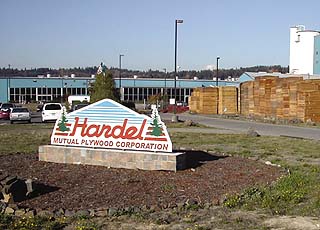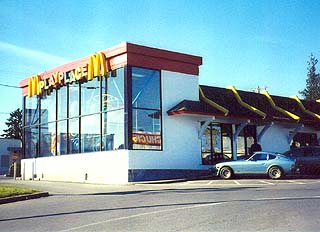
Surveys
DJC.COM
December 11, 2003
Are you paying too much property tax?
Lane Powell Spears Lubersky

Photo courtesy of Hardel Mutual
Competition from lower-priced imports reduced the value of Hardel Mutual’s five-year-old Chehalis mill far below its cost and the current assessment. |
Property taxes are based on the principle that the amount of tax paid should depend on the value of the property. A companion principle, established in the state constitution, is that all property should be valued and assessed uniformly.
Industrial properties — buildings, other improvements, machinery and equipment — are almost always valued uniformly, but too high. And even though commercial properties are, for the most part, valued accurately as well as uniformly, various circumstances may still present opportunities for tax savings.
Washington also imposes a leasehold excise tax in lieu of the property tax on payments for the use of public property. Because the leasehold tax often exceeds the amount of property tax that would otherwise be due, taxpayers may apply for a credit to offset the difference. Occasionally, the Department of Revenue will attempt to collect the tax on payments made to a government entity that are related to public property, but which actually represent payment for a concession or other purpose.
Commercial property valuation and assessment
Property tax assessments should be based on fair market value, commonly known as the price that would be set between the hypothetical willing buyer and willing seller. The statutory guidelines for valuing property prescribed for assessors reflect the three standard approaches to valuation — sales of the subject and similar properties, capitalization of income and cost less depreciation. The income approach generally provides the most accurate estimate of value for commercial properties.
Industrial properties typically assessed too high
Just about every industrial property owner pays too much tax — more so now due to the state of the economy. Industrial property assessments are based on original cost less “typical” depreciation. However, cost does not always equal value and the assessors' cost approach does not account for additional depreciation in the form of functional and economic obsolescence.
Economic obsolescence can be substantial for Pacific Northwest industries that have seen declining profits over the past decade. In some sectors, such as aerospace, forest products and food processing, the property tax assessment for a facility may actually be twice its value.
Common mistakes

Photo by Stephanie Hansen
The cost approach applies to special purpose properties. The failure of this Kitsap Way McDonald’s “PlayPlace” to generate income is an example of functional obsolescence, and was the basis for a property tax refund. |
Assessors have access to a fair amount of data on income, vacancy rates, expenses and sales data on which to base estimates of value for non-industrial commercial properties using the income approach. But an assessor's valuation can be too high if the market data relied upon is derived from properties that differ substantially from the taxpayer's in size, age, location, governmental restrictions or other factors that affect net income to be capitalized or the appropriate capitalization rate.
An assessor also may have erroneously relied upon data derived from non-arms' length transactions. For example, a buyer may pay a premium for the last parcel for an assemblage or because time is running out to complete a 1031 exchange. Or the assessor may erroneously assume that the “lease” payment in a sale of a business in the form of a sale-leaseback represents market rent.
Also, application of the income approach for hotel, assisted-living and shopping center properties may improperly include nontaxable intangible assets in the assessment.
Reducing taxes, getting refunds
Proactive taxpayers have several options for reducing property taxes, and even obtaining refunds for past overvaluations. They can approach the assessor informally to negotiate an appropriate valuation. But if an assessor is not responsive, taxpayers may file an appeal with the board of equalization by July 1 of the assessment year and also pay the taxes that come due the following year with a protest listing the reasons why the assessment is too high.
The protest and refund suit can also be used to obtain a refund for a prior year's overvaluation if no appeal to the board of equalization was filed for that year. And taxpayers who can show that the assessed value of a property is at least twice its market value may also obtain tax refunds for up to three years by requesting reconvening of earlier boards of equalization.
When an assessment is increased, the deadline for filing an appeal with the county board of equalization is July 1. But if a revaluation notice is sent late, the appeal deadline is 30 to 60 days after the notice was mailed, depending on the county.
| Get going on tax planning |
|
This is a good time to get a start on reducing next year’s property tax assessment or applying for a leasehold excise tax refund. And if taxpayers send in a proper protest with the April 30 tax installment next year, they can also try for a reduction in this year’s assessment to reduce their 2004 property taxes.
|
In any appeal process, taxpayers have a heavy burden. They must first demonstrate the errors in the assessor's valuation by “clear, cogent and convincing evidence” and then prove the correct valuation. Many property owners have sufficient command of valuation principles and the relevant market data to do this on their own, but most benefit from hiring an appraiser to both critique the assessment and provide an opinion of value.
Corrections and refunds are available in certain other circumstances. Incorrect assessments due to errors that do not involve valuation judgment, such as double assessments and description errors, and corrections due to changes in land use designations may be corrected for up to three prior years. An assessment may be revised for a prior year if the assessor was unaware of relevant facts, such as a remediation order for a contaminated property.
If property is sold after the first of July for 90 percent or less of the assessment, the tax paid the following year may be based upon the lower sale price. Forms for obtaining assessment reductions on these and other grounds, are available on the Web site for the Department of Revenue's property tax division (http://dor.wa.gov).
Leasehold excise tax savings
The leasehold excise tax is imposed on the privilege granted to a private entity to use or occupy publicly owned property. The tax is 12.84 percent of the rent paid to the public lessor. This amount is generally substantially greater than would be paid in property tax if the tenant owned the property. In such cases, the tenant is eligible for a credit against the leasehold excise tax in the amount of the difference between the leasehold tax and the property tax otherwise payable.
The credit may be claimed retroactively and a refund obtained for overpayment of the tax for the current and four prior years. Application for a refund must be filed with the state Department of Revenue. When the lessee and DOR have concluded the refund process, lessees should also be able to reach agreement with the DOR on a process for asserting the credit on an ongoing basis for future rent payments.
Kay Slonim is a property tax attorney in the Seattle office of Lane Powell Spears Lubersky LLP.
Other Stories:
- Insights Program looks at commercial real estate
- Town centers rediscovered after years of neglect
- Grocery stores cooking up more innovations
- Retail chic: Shopping centers with meeting places
- Development is changing; training should be, too
- When the government takes your property
- Don't get fenced in: Use a land title survey
- A new corridor may be coming down the Pike
- Columbia City — the next hot spot?
- Yakima Valley real estate heats up
- Northwest taps into waterfront properties
- Interest rate hike could mean time to sell
- David A. Sabey
- James N. Carbone
- John Solberg
- Mic Dinsmore
- Mark A. Weed
- Portland's economic Rx: a biotech future
- The recovery train has left the station: Are we on it?
- Are hotels overbuilt or just overproposed?
- Tax credit program boosts low-income communities
- Debt can be good for nonprofits' projects
Copyright ©2009 Seattle Daily Journal and DJC.COM.
Comments? Questions? Contact us.